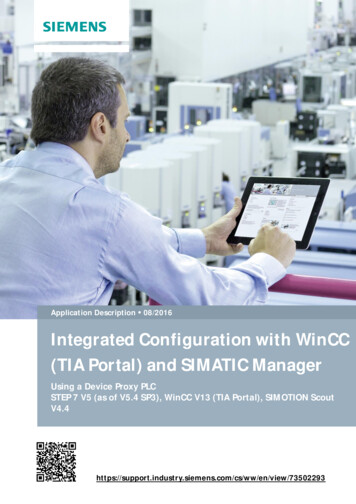
Transcription
Application Description 08/2016Integrated Configuration with WinCC(TIA Portal) and SIMATIC ManagerUsing a Device Proxy PLCSTEP 7 V5 (as of V5.4 SP3), WinCC V13 (TIA Portal), SIMOTION w/en/view/73502293
Warranty and LiabilityWarranty and LiabilityNoteThe Application Examples are not binding and do not claim to be completeregarding the circuits shown, equipping and any eventuality. The ApplicationExamples do not represent customer-specific solutions. They are only intendedto provide support for typical applications. You are responsible for ensuring thatthe described products are used correctly. These Application Examples do notrelieve you of the responsibility to use safe practices in application, installation,operation and maintenance. When using these Application Examples, yourecognize that we cannot be made liable for any damage/claims beyond theliability clause described. We reserve the right to make changes to theseApplication Examples at any time without prior notice.If there are any deviations between the recommendations provided in theseApplication Examples and other Siemens publications – e.g. Catalogs – thecontents of the other documents have priority.ã Siemens AG 2016 All rights reservedWe do not accept any liability for the information contained in this document.Any claims against us – based on whatever legal reason – resulting from the use ofthe examples, information, programs, engineering and performance data etc.,described in this Application Example shall be excluded. Such an exclusion shallnot apply in the case of mandatory liability, e.g. under the German Product LiabilityAct (“Produkthaftungsgesetz”), in case of intent, gross negligence, or injury of life,body or health, guarantee for the quality of a product, fraudulent concealment of adeficiency or breach of a condition which goes to the root of the contract(“wesentliche Vertragspflichten”). The damages for a breach of a substantialcontractual obligation are, however, limited to the foreseeable damage, typical forthe type of contract, except in the event of intent or gross negligence or injury tolife, body or health. The above provisions do not imply a change of the burden ofproof to your detriment.Any form of duplication or distribution of these Application Examples or excerptshereof is prohibited without the expressed consent of the Siemens AG.SecurityinformationSiemens provides products and solutions with industrial security functions thatsupport the secure operation of plants, systems, machines and networks.In order to protect plants, systems, machines and networks against cyberthreats, it is necessary to implement – and continuously maintain – a holistic,state-of-the-art industrial security concept. Siemens’ products and solutions onlyform one element of such a concept.Customer is responsible to prevent unauthorized access to its plants, systems,machines and networks. Systems, machines and components should only beconnected to the enterprise network or the internet if and to the extent necessaryand with appropriate security measures (e.g. use of firewalls and networksegmentation) in place.Additionally, Siemens’ guidance on appropriate security measures should betaken into account. For more information about industrial security, please mens’ products and solutions undergo continuous development to make themmore secure. Siemens strongly recommends to apply product updates as soonas available and to always use the latest product versions. Use of productversions that are no longer supported, and failure to apply latest updates mayincrease customer’s exposure to cyber threats.To stay informed about product updates, subscribe to the Siemens IndustrialSecurity RSS Feed under ion Device Proxy-PLCEntry ID: 73502293, V3.0, 08/20162
Table of ContentsTable of ContentsWarranty and Liability . 21Task. 42Solution. 62.12.22.2.12.2.22.2.32.32.3.12.3.2ã Siemens AG 2016 All rights reserved3Overview . 6Description of the core functionality. 7General notes on the configuration . 7Supported controllers. 8Supported alarm procedures. 8Hardware and software components . 8Validity . 8Components used . 9Configuration and Settings . 7.23.7.33.8Creating a device proxy PLC . 10Initializing the project . 12Updating device proxy data. 22Tag handling. 27GSD/GSDML files. 29Installing GSD/GSDML files . 29KTP Mobile Panel . 31Direct buttons . 37Communication via PROFINET IO . 37Communication via PROFIBUS . 40Routing. 43General information . 43Example 01 . 44Example 02 . 49H controller . 544Restrictions . 555Links & Literature . 566History . 56Integration Device Proxy-PLCEntry ID: 73502293, V3.0, 08/20163
1 Task1TaskIntroductionThe TIA Portal offers the option to create the PLC program and theHMI configuration via software interface including all the resulting advantages.It is necessary in some cases, for technical or plant-specific reasons, to continuecreating the PLC program with the STEP 7 software as of version V5.4 SP3 andthe HMI configuration with the WinCC (TIA Portal) software.If HMI projects are created without integrated controller connection1 this leads tothe following disadvantages:Tags for the HMI project have to be created manually.·No symbolic tag connection.·Changes/expansions of tags in the SIMATIC Manager, which affect the HMIconfiguration have to be manually updated in the HMI configuration.·Controller-specific alarm procedures, such as “Alarm D” are not available.ã Siemens AG 2016 All rights reserved·1Integrated controller connection. The HMI project is integrated in the SIMATIC Manager or theWinCC (TIA Portal).Integration Device Proxy-PLCEntry ID: 73502293, V3.0, 08/20164
1 TaskOverview of the automation taskThe figure below provides an overview of the automation task.Figure 1-1ã Siemens AG 2016 All rights reservedSIMATIC Manager-Tag handling?-Symbolic access to tags?-Alarm S / Alarm D?WinCC V13 (TIA Portal)TP1200 Comfort PanelDescription of the automation taskThe PLC program was created with SIMATIC software STEP 7 V5.4 SP3 (orhigher) and includes an MP 277 10“ touch operator panel, created withWinCC flexible.The MP 277 10“ touch operator panel shall be replaced with a TP1200 Comfortoperator panel.Tag handling, alarm procedures “Alarm S” and “Alarm D”, as well as reportingsystem error (SFM) shall be possible between WinCC V13 and the SIMATICManager, in the same way as for a WinCC flexible project integrated in theSIMATIC Manager.Integration Device Proxy-PLCEntry ID: 73502293, V3.0, 08/20165
2 Solution2.1 Overview2Solution2.1OverviewWinCC V13 (TIA Portal) offers the option to configure a “Device Proxy PLC”.The “device proxy PLC” enables direct access to the SIMATIC controllersconfigured in the SIMATIC Manager and their current data such as symbols, datablocks and the alarm procedures “Alarm S”, “Alarm D” and “SFM” and to integratethem into WinCC (TIA Portal).The handling can be compared with a WinCC flexible project integrated in theSIMATIC Manager.NoteWhen mentioning the “SIMATIC Manager” in this document, then this alwaysrefers to the versions “as of STEP 7 V5.4 SP3”.ã Siemens AG 2016 All rights reservedWhen mentioning WinCC V13 in this document, this always refers to the version“as of WinCC V13 (TIA Portal)”.Schematic layoutThe figure below shows a schematic overview of the most important components ofthe solution:Figure 2-1SIMATIC ManagerAccess to the tags in the SIMATIC Manager by using a device proxyPLC in the WinCC V13 (TIA Portal) projectWinCC V13 (TIA Portal)Proxy PLCIntegration Device Proxy-PLCEntry ID: 73502293, V3.0, 08/20166
2 Solution2.2 Description of the core functionalityAdvantagesAs described in chapter 1, in some cases it is necessary for technical or plantspecific reasons to create the HMI configuration separately. However, in order tobe able to still use the advantages of an integrated controller connection, theDevice Proxy PLC was developed.You can still program the PLC program with the SIMATIC Manager and the HMIconfiguration with WinCC V13 (TIA Portal) in order to be able to use the Comfortpanels, for example.With the device proxy PLC you can use functionalities which are similar to thoseyou are familiar with from the HMI operator panel integrated in the SIMATICManager. Details on handling are described in chapter 3.Topics not covered by this applicationã Siemens AG 2016 All rights reservedThis application does not include a description ·of the configuration interface of SIMATIC Manager,·of the configuration interface of TIA Portal,·of the HMI operator panels used.Basic knowledge of these topics is assumed. If required, please refer to theappropriate manuals (see chapter 5).Required knowledgeFor the implementation of the presented solutions, no particular knowledge isnecessary. Basic knowledge on the configuration interface of the SIMATICManager and the WinCC (TIA Portal) is assumed.2.2Description of the core functionalityThe core functionality is the description of how to integrate and use a device proxyPLC in a WinCC V13 project.2.2.1General notes on the configuration·In the SIMATIC Manager, all necessary software option packages used in theSTEP 7 project need to be installed. If, for example, a T CPU is used in theSTEP 7 project, then the “S7 Technology” option has to be installed as well.·The project in the SIMATIC Manager needs to be consistent.–Select the program block folder of the CPU with the right mouse button.–Select the “Check block consistency.” item from the context menu.–Execute the “Program Compile all” menu command from the dialogwindow.Integration Device Proxy-PLCEntry ID: 73502293, V3.0, 08/20167
2 Solution2.3 Hardware and software componentsã Siemens AG 2016 All rights reserved2.2.22.2.3·In the application, you do not necessarily need to migrate a WinCC flexibleproject to WinCC V13.Parallel to the SIMATIC Manager and WinCC flexible, you can use the WinCCV13 software in order to expand an existing STEP 7 plant configuration withComfort panels.·With the device proxy PLC, changes in the SIMATIC Manager can be easilyaccepted and updated in the WinCC V13 configuration.Supported controllers·S7-300 controller·S7-300F controller·S7-400 controller·S7-400F controller·S7-400H controller·S7-300 T controller·ET200 controller (IM 151-7 CPU)·ET200 controller (IM 151-8 CPU)·SIMOTION CPUs with kernel/firmware versions V4.4 and V4.3Supported alarm procedures·Discrete alarm procedure·Analog alarm procedure·Reporting system error (SFM)·Alarm S·Alarm D2.3Hardware and software components2.3.1ValidityThis application is valid for.Note·MS Windows 7 Ultimate, Professional and Enterprise (standard installation)·all operator panels that are configurable with WinCC V13 SP1 Basic andhigher,·as of STEP 7 V5.4 SP3,·as of WinCC V13 Basic,·as of SIMOTION Scout 4.4STEP 7 V13 is not required.Integration Device Proxy-PLCEntry ID: 73502293, V3.0, 08/20168
2 Solution2.3 Hardware and software components2.3.2Components usedThe application has been created using the following components:Hardware componentsTable 2-1ComponentQty.Order numberNoteCPU 317-2 PN/DP16ES7 317-2EK14-0AB0For other supportedcontrollers, see chapter 2.2MP 277 10“ Touch16AV6643-7CD00-0CJ1For other operator panels, seechapter 2.3.1TP1200 ComfortPanel16AV2124-0MC01-0AX0The use of Basic Panels isalso possible.Software componentsTable 2-2ã Siemens AG 2016 All rights reservedComponentQty.Order numberNoteSTEP 7 V5.516ES7810-4CC10-0YA5Possible as of STEP 7 V5.4SP3WinCC flexible 2008SP316AV6613-0AA51-3CA5For SPs, see Online SupportWinCC V13 SP1Advanced16AV2100-0AA03-0AA5As of WinCC V13 BasicExample fileThe following list includes the file used in this example.Table 2-3Component73502293 WinCC TIA STEP7 V5 Proxy DOKU v20.pdfIntegration Device Proxy-PLCEntry ID: 73502293, V3.0, 08/2016NoteThis document9
3 Configuration and Settings3.1 Creating a device proxy PLC3Configuration and Settings3.1Creating a device proxy PLCPreparatory measuresA STEP 7 program with an MP 277 10“ touch integrated in the SIMATIC Manageris used for initial configuration.For further usage, the MP 277 Touch was migrated to WinCC V13 and replacedwith a TP1200 Comfort Panel.How to migrate a WinCC flexible project integrated in the SIMATIC Managerto WinCC (TIA Portal) is described in FAQ entry 54695062.You do not necessarily need to migrate an existing WinCC flexible configuration to WinCCV13. For this purpose, please refer to chapter 2.2.1 “General notes on the configuration”.NoteTable 3-1ã Siemens AG 2016 All rights reservedNo.1.ActionAdding a new device··Open the WinCC V13 (TIA Portal) project with the TP1200 Comfort Panel.Click “Add new device” on the menu item in the project tree.Integration Device Proxy-PLCEntry ID: 73502293, V3.0, 08/201610
3 Configuration and Settings3.1 Creating a device proxy PLCã Siemens AG 2016 All rights reservedNo.2.Action·This will open the context window “Add new device”.···Select the “Controller” option in the window.From the “Controller” list, select “Device Proxy” and the listed device.Click on “OK” to acknowledge the selection.View of the device proxy PLC·The figure below shows the inserted device proxy PLC in the device view. The device proxyPLC was not yet initiated and does not include any data.The further procedure is described in the following chapters.Integration Device Proxy-PLCEntry ID: 73502293, V3.0, 08/201611
3 Configuration and Settings3.2 Initializing the project3.2Initializing the projectInitializing establishes a connection to a CPU within the SIMATIC Manager.After completing the initialization, the tags and alarms contained in the SIMATICManager are displayed in the WinCC V13 project and can be used as usual.Table 3-2No.1.ActionOpening the device configurationã Siemens AG 2016 All rights reserved·2.Open the device configuration of the device proxy PLC and go to the “Device view”.Initializing the device proxy PLC··Right-click the device proxy PLC (“PLC Proxy”). A context window opens. Then select the“Initialize device proxy” option.A file selection dialog opens.Integration Device Proxy-PLCEntry ID: 73502293, V3.0, 08/201612
3 Configuration and Settings3.2 Initializing the projectNo.ActionInitializing the device proxy PLC – alternative call option·ã Siemens AG 2016 All rights reserved·3.Right-click the device proxy PLC directly in the project tree. A context window opens. Thenselect the “Initialize device proxy” option.A file selection dialog opens.Selecting the STEP 7 V5.x configurationSelecting the SIMOTION V4.4 configurationA description is available in the followingsection 4 (link).A description is available in the followingsection 5 (link).Integration Device Proxy-PLCEntry ID: 73502293, V3.0, 08/201613
3 Configuration and Settings3.2 Initializing the projectNo.4.ActionSelecting the STEP 7 V5.x configuration (for SIMOTION see section 5)ã Siemens AG 2016 All rights reserved···5.Navigate to the folder which contains the STEP 7 project via the file selection dialog.Select the “*.s7p” file and click the “Open” button.This starts the initialization and the “Initialize device proxy” window is displayed.Selecting the SIMOTION V4.4 configuration····Navigate to the folder which contains the STEP 7 project via the file selection dialog.Open the “U7” folder.Select the “*.mcp” file and click the “Open” button.This starts the initialization and the “Initialize device proxy” window is displayed.Integration Device Proxy-PLCEntry ID: 73502293, V3.0, 08/201614
3 Configuration and Settings3.2 Initializing the projectNo.6.Action“Initialize device proxy” window··ã Siemens AG 2016 All rights reserved··If the SIMATIC Manager contains several controllers, you can select the CPU to beassigned to the device proxy PLC via the drop-down menu.In this example, the PLC program “Project 02/CPU317-2PN/DP” was selected.Individual program blocks, the symbolism and the PLC alarms can be selected in the“Device proxy data content” window. Due to the selection, only the data necessary for theHMI configuration is included in the WinCC V13 configuration.Confirm the selection via the “OK” button.The initialization is started.Integration Device Proxy-PLCEntry ID: 73502293, V3.0, 08/201615
3 Configuration and Settings3.2 Initializing the projectNo.7.ActionView of the created program structure in WinCC V13·After successful initialization, the previously selected data are displayed in the programfolders as usual.ã Siemens AG 2016 All rights reservedNoteThe data cannot be processed in WinCC V13. There is only read access to the tags (greyedrepresentation). Changes in the STEP 7 program are always made in the SIMATIC Manager.8.Display of the original program nameThe original station name/CPU name of the PLC program is displayed as follows:··Open the device configuration of the device proxy PLC and go to “Device view”.The original program name is displayed in the “Properties General General DeviceProxy Information” parameter.Integration Device Proxy-PLCEntry ID: 73502293, V3.0, 08/201616
3 Configuration and Settings3.2 Initializing the projectNo.9.ActionCreating a network connection between HMI and PLC··ã Siemens AG 2016 All rights reserved·Configure a network connection between the HMI operator panel used and the device proxyPLC in the same way as when using a “standard PLC”. Here you select the “Network view”in the device configuration.Select the device proxy PLC and enter the same connection properties in “Properties” asthose of the PLC program in the SIMATIC Manager.Network and connect both devices.Note on network connection and addressesControl the respective addresses and bus parameters of the modules used and adjust them, ifnecessary, irrespective of whether an Ethernet connection or a PROFIBS connection wascreated.If you are using PROFIBUS, please note the additional information at the end of this chapter(link).Integration Device Proxy-PLCEntry ID: 73502293, V3.0, 08/201617
3 Configuration and Settings3.2 Initializing the projectNo.10.ActionAdapting connection namesBy networking the HMI operator panel with the device proxy PLC, the system creates aconnection and assigns a connection name.If a connection already exists, it may be sensible to adapt the new connection name.This is the case in the following scenarios.11. An HMI operator panel, integrated in the SIMATIC Manager and created with WinCCflexible, has been migrated to WinCC (TIA Portal).12. You have an existing WinCC (TIA Portal) configuration without integrated controllerconnection and you would like to use the advantages by using the device proxy PLC.ã Siemens AG 2016 All rights reservedWhen adapting the connection name in the two above mentioned examples, you do not need tomake any changes or adjustments later in the tag editor in “Connections”.Adapting connection names– Copy the “old” connection name.– Delete the “old” connection.– Replace the “new” connection name with the connection name of the “old” connection.Integration Device Proxy-PLCEntry ID: 73502293, V3.0, 08/201618
3 Configuration and Settings3.2 Initializing the projectNo.9.ActionSymbolic tag connection······Call the tag editor.Select all tags.Click the “Synchronize with the PLC tag” button. The “Options for synchronization of WinCCtags” window opens.Select the options “Data type and absolute address match” as well as “Replace WinCC tagname with PLC tag name” in the window.Click the “Synchronize” button.Synchronization of the tags is executed.ã Siemens AG 2016 All rights reservedThus, the initialization is completed.PROFIBUS additional information ( )If more than one HMI operator panel has been networked with the device proxyPLC via PROFIBUS, the properties of the PROFIBUS parameters need to beadjusted in the STEP 7 5.x project in the following cases.·You have a STEP 7 V5.x project. The HMI operator panels existing in thisproject and created with WinCC flexible were migrated to WinCC (TIA Portal)and networked with the device proxy PLC.·You have a STEP 7 V5.x project. The HMI operator panels were onlyconfigured with WinCC (TIA Portal) and are networked with the device proxyPLC.Integration Device Proxy-PLCEntry ID: 73502293, V3.0, 08/201619
3 Configuration and Settings3.2 Initializing the projectProcedureTable 3-3No.1.ActionAdapting the PROFIBUS profile·····ã Siemens AG 2016 All rights reserved·Open the hardware configuration of the CPU in the SIMATIC Manager.Open the properties of the PROFIBUS interface of the CPU.In the “Properties - MPI/DP” window, select the “Properties ” button in the “General” tab.Select the “Properties ” button in the “Parameters” tab in the “Properties – PROFIBUSinterface” window.In the “Properties – PROFIBUS” window, select the “Standard” profile in “Network Settings Profile”.Then, in the same window, select the “Options ” button.Integration Device Proxy-PLCEntry ID: 73502293, V3.0, 08/201620
3 Configuration and Settings3.2 Initializing the projectNo.2.ActionWindow “Options”. Consider the network configurationAfter more than three HMI operator panels have been networked with the device proxy PLC,specify the number of active stations as follows.Active stations number of HMI operator panels minus 2ExampleNumber of HMI operator panels 5 active stations 3Enable the “Include network configuration below” option box.Enter the number of stations next to “Active stations with FDL/FMS/S7 communicationload”.·Then, click “OK” to confirm all entries.ã Siemens AG 2016 All rights reserved··Integration Device Proxy-PLCEntry ID: 73502293, V3.0, 08/201621
3 Configuration and Settings3.3 Updating device proxy data3.3Updating device proxy dataData in the device proxy PLC always need to be updated when expansions orchanges have been made in the SIMATIC Manager which affect the HMI operatorpanel. This is the case, for example, if address areas in the data blocks have beenchanged or expanded.With regard to the example, two tags have been added later in DB1.ã Siemens AG 2016 All rights reservedFigure 3-1Integration Device Proxy-PLCEntry ID: 73502293, V3.0, 08/201622
3 Configuration and Settings3.3 Updating device proxy dataTable 3-4No.1.ActionUpdating device proxy data···Right-click to select the device proxy PLC in the project tree. A context menu opens.Then, select the “Update device proxy data” option.A file selection dialog opens.ã Siemens AG 2016 All rights reservedNoteAlternatively, you can also update via the device configuration.·Open the device configuration of the device proxy PLC and go to the “Device view”.·Right-click the device proxy PLC (“PLC Proxy”). A context window opens. Then, select the“Update device proxy data” option.2.Selecting the STEP 7 V5.x configurationSelecting the SIMOTION V4.4 configurationA description is available in the followingsection 3 (link).A description is available in the followingsection 4 (link).Integration Device Proxy-PLCEntry ID: 73502293, V3.0, 08/201623
3 Configuration and Settings3.3 Updating device proxy dataNo.3.ActionSelecting the STEP 7 V5.x configuration·ã Siemens AG 2016 All rights reserved··4.Navigate to the folder which contains the STEP 7 project used for initializing the deviceproxy PLC via the file selection dialog. The repeated selection ensures that the sameproject is used again.Select the “*.s7p” file and click the “Open” button.The “Update device proxy data” window is displayed.Selecting the SIMOTION V4.4 configuration···Navigate to the folder which contains the SIMOTION project used for initializing the deviceproxy PLC via the file selection dialog. The repeated selection ensures that the sameproject is used again.Select the “*.mcp” file and click the “Open” button.The “Update device proxy data” window is displayed.Integration Device Proxy-PLCEntry ID: 73502293, V3.0, 08/201624
3 Configuration and Settings3.3 Updating device proxy dataNo.5.ActionWindow “Update device proxy data”····In the update dialog, select the same CPU as data source that has been used for theinitialization of the device proxy PLC.An update with another HW configuration is not permitted.In this window, you have the option to additionally select newly created data blocks from theSIMATIC Manager. Only selected objects are adopted in the WinCC V13 project.Confirm the selection via the “OK” button.Updating the tags is started.ã Siemens AG 2016 All rights reservedNoteAll data selected during the previous initialization are automatically selected again. Thispresetting should only be changed if you consciously wish to remove data from the device proxyPLC.If, for example, the DB1 was integrated into the WinCC V13 project through the initialization,and you now disable the DB1, then the data of DB1 are deleted in the WinCC V13 projectduring updating.6.View of the newly added tags in the WinCC V13 projectProgram blocks of the device proxy PLCThe left side shows DB1 with the individual tags before the update.The right side shows DB1 with the added tags after the update.Integration Device Proxy-PLCEntry ID: 73502293, V3.0, 08/201625
3 Configuration and Settings3.3 Updating device proxy dataNo.7.ActionHMI tag editor in the WinCC V13 projectã Siemens AG 2016 All rights reservedWith the symbolic tag connection, the addresses of the tags have been automatically adapted aswell.In this example, the address of the “AirPressure” tag has been adjusted from “DB1.DBW0” to“DB1.DBW2”.This completes the update of the tags.Integration Device Proxy-PLCEntry ID: 73502293, V3.0, 08/201626
3 Configuration and Settings3.4 Tag handling3.4Tag handlingWith the initialization of the device proxy PLC, you have integrated the tags fromthe SIMATIC Manager into the WinCC V13 project.The tags are inserted into the HMI configuration in the same way as when using a“standard PLC”.The two examples show how you can effectively insert the tags of the device proxyPLC into an HMI screen.Table 3-5No.1.ActionExample 1: Inserting tags directly into the HMI screenã Siemens AG 2016 All rights reserved··Open the program block folder of the device proxy PLC in the project navigation.Select the block which contains the tags. In this example, the “DB1 Weather” block hasbeen selected.·In the “Details view”, all tags of the previously selected block are displayed.·Select a tag in the “Details view” with the left mouse button and drag it to the “Work area”via “drag & drop”.An I/O field with the selected tag is automatically created. You can make further settings in the“inspector window”.Work areaProject navigationDetails viewIntegration Device Proxy-PLCEntry ID: 73502293, V3.0, 08/2016Inspector window27
3 Configuration and Settings3.4 Tag handlingNo.2.ActionExample 2: Inserting the tag into an existing I/O fieldSpecification:An I/O field is available in the HMI screen and the “Properties” have been selected.··Open the program block folder of the device proxy PLC in the project navigation.Select the block which contains the tags. In this example, the “DB1 Weather” block hasbeen selected.·In the “Details view”, all tags of the previously selected block folder are displayed.·Select a tag in the “Details view” with the left mouse button and drag it to the “Inspectorwindow” via “drag & drop”.The I/O field is connected with the selected tag. You can make further settings in the “Inspectorwindow”.Project navigationã Siemens AG 2016 All rights reservedWork areaDetails viewInspector windowFor further usage, the MP 277 Touch is migrated to WinCC V13 and replaced witha TP1200 Comfort Panel.Integration Device Proxy-PLCEntry
When mentioning WinCC V13 in this document, this always refers to the version "as of WinCC V13 (TIA Portal)". Schematic layout The figure below shows a schematic overview of the most important components of the solution: Figure 2-1 SIMATIC Manager WinCC V13 (TIA Portal) Proxy PLC Access to the tags in the SIMATIC Manager by using a device proxy
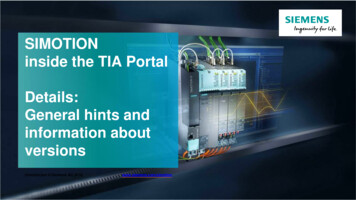
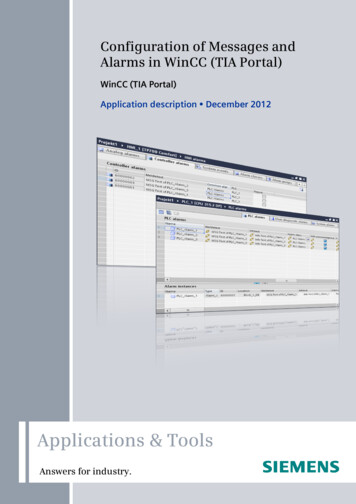
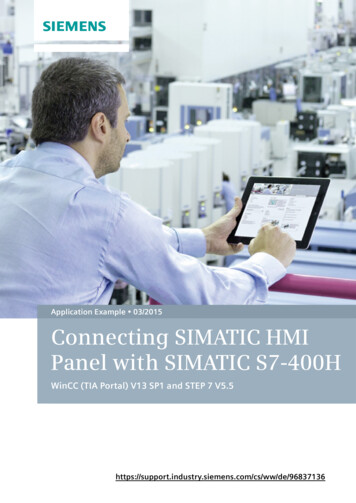
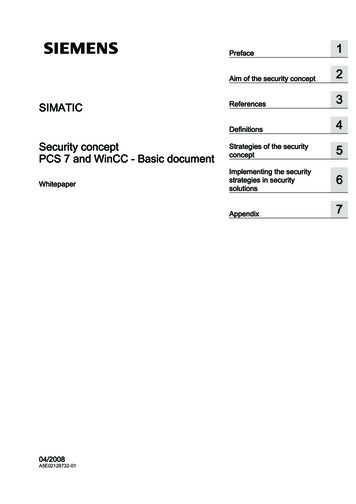
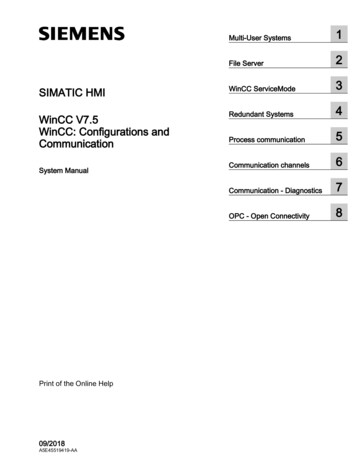
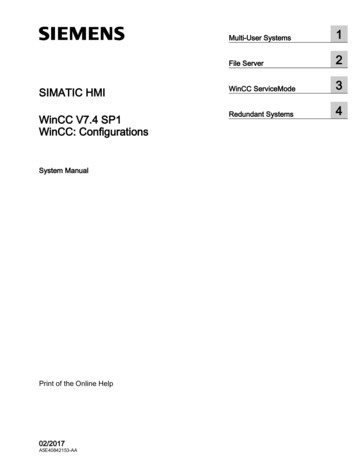
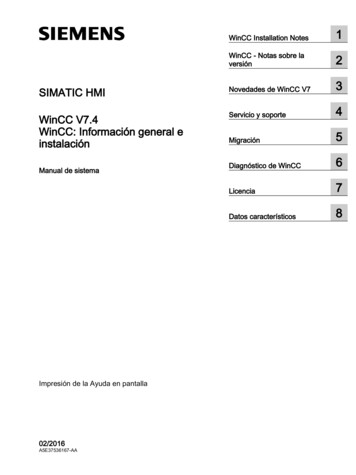
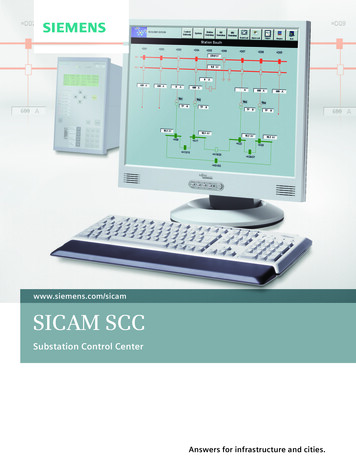

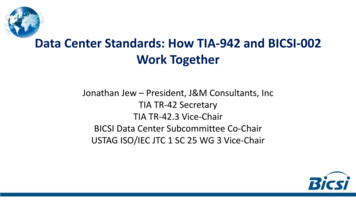
![[VERIFIED] Siemens Tia Portal V11 Crack 49 8](/img/66/olwder.jpg)